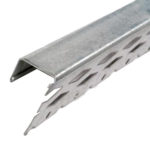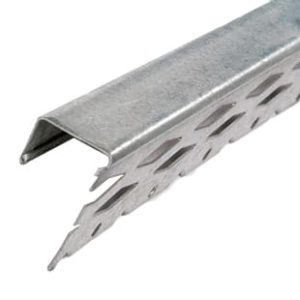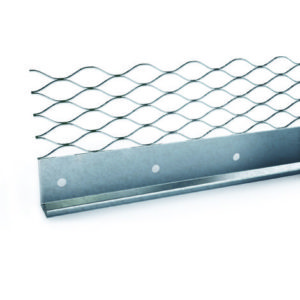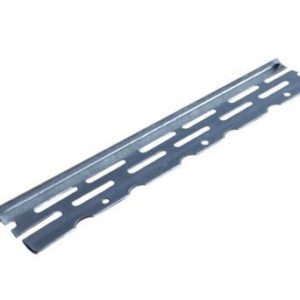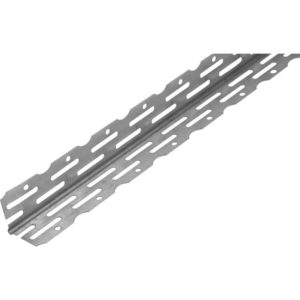Plaster Beads
Plaster beads are used to ensure that you strengthen corners, edges, junctions or the top of constructions while eliminating damaging impact. There are different types of plastering beads which allow for achieving high-quality and seamless job results. You can place them on a pre-plastered base, on a wall plasterboard or on top of a brick, and plaster beading will ensure structural support alongside keeping sharp and clean lines to the appearance.
What is Plaster beading?
A plasterboard bead is a thin piece of metal or plastic used in plastering and rendering. Plaster beads are usually applied around concerns such as door frames, windows, stairwells, support beams or at the edging to protect the edges’ vulnerability from cracking while keeping their seamless visual finish.
Types of Plaster Beads
Whether it is external or internal plasterwork, choosing a particular plastering beads type depends on your project’s location and specific requirements.
1.1. Plasterboard Angle Bead
Plasterboard angle beads are applied to achieve a smooth 90-degree corner when two sheets of plasterboard are joined. While having a rigid spine covering the apex of a corner, with two wings on either side, they also protect them.
Angle beads can be applied to support beams, stairwells and window corners. Plastering angle beads have dimensions of 2.4m or 3.0m lengths with a general depth of finished plaster layer of no more than 3mm. Having specific sizes, they serve as an illustration to the depth when coating external walls.
1.2. Plasterboard Edge Bead
Edge beads are long strips with a solid hooked corner on one side and an edge with a perforated or mesh wing on the other. They are applied to your plasterboard sheet to create a defined edge while plastering and rendering.
Edge beads help to protect plasterboard edges while placed next to various building materials, including wooden window or door frames, stone walls, suspending ceilings and other building materials. You can avoid water seepage by applying a silicone sealant to the back edge of the edge bead. Alongside the protection function, plasterboard edge beads facilitate you to achieve a carefully performed and professional job appearance.
1.3. Plasterboard Corner bead
Corner beads, also known as Angle beads, usually come in two types, with perforated or mesh wings on either 90-degree sides. Generally, corner beads with perforated wings are used if beads are nailed, while the mesh edges of the corner beads mesh are applied with a skim plaster mixture.
Plasterboard corner beads reinforce and protect corners, especially external ones while ensuring a high-quality visual finish. They simplify the plastering and rendering processes. Corner beads allow the render to be flexibly applied while preventing cracking by taking pressure from external forces inside or outside the building.
1.4. Plasterboard Stop bead
Plaster Stop beads, also called plaster edge beads, are long, thin strips with a perforated or mesh side fixed to a wall before skim plastering. This allows you to simplify the plastering process by dividing the whole wall into small manageable plastering areas and receive a smooth, clean and level edge to finish the plastering process.
The perforated or the mesh side of plastering stop beads has a dimension of 2.4m or 3.0m in length. In contrast, the rigid edge generally has a size of no more than 3mm in depth as it is usually a finished plaster skim layer.
How to choose the right plaster beading material
To achieve the desired results, it is imperative that you consider high-quality plaster beading materials and select the right one for your project needs.
The location and conditions where plaster beads will be placed are crucial as they define the proper plasterboard type selection. Using the relevant plaster beading material for your project, you can ensure a neat, long-lasting, professional appearance.
2.1. Stainless plasterboard beads
Stainless plaster beads can be applied in both internal and external plastering. The capacity of stainless steel for corrosion resistance facilitates using it in areas with high moisture. In particular, they are perfect for bathrooms, kitchens or swimming pools while preventing water accumulation. Stainless plastering beads are generally applied when cement-based plastering is used.
2.2. Galvanaised plasterboard beads
Galvanised plaster beads are commonly used for internal plasterwork in mild climate areas. The zinc coating protects the steel from corrosion and allows you to achieve a high-quality standard for your interior plasterwork project.
2.3. PVC plasterboard beads
Made from PolyVinylChloride, PVC plaster beads can be used in external and internal plastering. These plaster beads are highly resistant to aggressive climate conditions, including areas with high moisture and salt-laden presence.
Benefits of galvanised plasterboard beads:
- They are lightweight, which allows you to handle them with ease
- They can be easily cut, unlike other metal plaster beads
- Have greater strength and stiffness capability
- Allow completing neat fixing quickly
- Are cost-efficient by reducing the amount of waste in plastering
How to use Plaster Beads?
How you will install plaster beads on plasterboards depends on the type of beads you will apply, which will also determine the instruments to be used.
4.1. How to Install Angle Beads on Your Plasterboard Corners
You can install angle plaster beads to your plasterboard using different techniques and instruments.
Firstly, you should prepare your angle beads for installation by measuring the required length, cutting them from either side with strong scissors or tin snips, and then breaking them up in the middle. To achieve perfect plasterwork, you are advised to use a ruler and draw a visual line where you will install the angle beads to the plasterboard. Also, as the edges of angle beads tend to be wide open, cutting them at about 45 degrees is recommended to avoid any issues later on.
When your angle beads are prepared, you can install them to the plasterboard in several ways, including nails, staples or screws. The most commonly used method by specialists is stapling, as staples can be easily removed while facilitating you to quickly and carefully adjust your angle beads. Although, make sure you have a solid staple gun to staple your angle beads in the bottom and top of both sides and in the middle while carefully holding the staple gun in place with a straight edge.
4.2. How to Install Edge Beads on Your Plasterboard Edges
The critical difference in installing edge beads from angle beads is that you should fix them to your plasterboard surface before you attach a plaster sheet to a wall. You can follow the same procedure as with angle beads to prepare the fixing and use the same instruments, like a pair of tin snips, as you do to cut angle beads.
It is also possible to apply a similar practice of installation approaches as with angle beads; however, ensuring that the smaller bead is placed on the plasterboard while the longer part is on the back is crucial.
4.3. How to Install Stop Beads on Your Plasterboard
As with angle beads, you have to prepare your stop beads to be installed on your plasterboard. You should measure the necessary length of the plastering beads, mark them and then cut using a pair of tin snips or a hacksaw.
You can nail them using unique galvanised nails when the stop beads are ready for installation. Otherwise, you can fix stop beads on your plasterboard using skim plaster. This is the preferred method used by most professionals as it is cost-efficient, although it requires experience and can be challenging for a new starter.
If you decide to skim the stop beads to your plasterboard, draw a line with a pencil to mark where it will be installed. Then put tiny drops of skim along the drawn line at a distance of about 1 m with a float trowel. After placing the stop bead on the line with skimmed dots, push it while waiting about 5 minutes for the plasterboard to become set. The last step is carefully removing the unnecessary plaster beyond the depth level of the stop bead.
4.4. How to Install Corner Beads on Your Plasterboard
Alongside stapling, the most popular fixing method of angle beads among professionals, you can also use nailing and screws to install your corner beads on your plasterboard. Although nails can be difficult to remove, and they can drag the corner of the bead away, nailing is not as popular as screws, which let you achieve more careful fixing. However, to ensure the screws are hidden under the plaster, you should place them deep enough to create a depression in the corner bead.
Conclusion
Plaster beads are essential to your plastering work as they protect your plasterboard walls and other building contractions.
Our professional staff can help you to choose the best type of plaster beads for your project needs while assisting in applying the necessary installation techniques to ensure high-quality job results and outstanding appearance.
Please contact us at 0203 318 7316; we will be happy to answer any questions.
Showing all 10 results
-
Galvanised 12.5mm Plasterboard Edge Bead 3m Pack of 50
Galvanised steel channel forms a defined edge to plasterboard areas. Symmetric profile with one perforated leg and pre-formed arris to accommodate jointing material.
£133.81£160.57 Ex VATInc VAT£2.68£3.22 Per Unit Add to cart -
Galvanised 13mm Plaster Stop Bead 2.4m Pack of 50
Plaster Stop Beads are designed to provide a neat finish for edges and openings that are being plastered.
£84.12£100.94 Ex VATInc VAT£1.68£2.02 Per Unit Add to cart -
Galvanised 13mm Plaster Stop Bead 3.0m Pack of 50
Plaster Stop Beads are designed to provide a neat finish for edges and openings that are being plastered.
£109.36£131.23 Ex VATInc VAT£2.19£2.63 Per Unit Add to cart -
Galvanised 15mm Plasterboard Edge Bead 3m Pack of 50
Galvanised steel channel forms a defined edge to plasterboard areas. Symmetric profile with one perforated leg and pre-formed arris to accommodate jointing material.£133.81£160.57 Ex VATInc VAT£2.68£3.22 Per Unit Add to cart -
Galvanised Drywall Stop Bead 2.4m Pack of 50
This Galvanised thin coat stop bead is designed specifically for thin coat finishes and helps create a barrier resistant to cracking and impact damage. Manufactured from 0.4mm thick galvanised steel.
£105.16£126.19 Ex VATInc VAT£2.10£2.52 Per Unit Add to cart -
Galvanised Drywall Stop Bead 3.0m Pack of 50
This Galvanised thin coat stop bead is designed specifically for thin coat finishes and helps create a barrier resistant to cracking and impact damage. Manufactured from 0.4mm thick galvanised steel.
£134.61£161.53 Ex VATInc VAT£2.69£3.23 Per Unit Add to cart -
Galvanised Drywall Thin Coat Angle Bead 2.4m Pack of 50
Plaster depth 2-3mm. Nail holes for easy fix with drywall nails. Scalloped edge for an excellent plaster key. Internal use only.
£50.45£60.54 Ex VATInc VAT£1.01£1.21 Per Unit Add to cart -
Galvanised Drywall Thin Coat Angle Bead 3m Pack of 50
Plaster depth 2-3mm. Nail holes for easy fix with drywall nails. Scalloped edge for an excellent plaster key. Internal use only.
£60.00£72.00 Ex VATInc VAT£1.20£1.44 Per Unit Add to cart -
Galvanised Standard Angle Bead 2.4m Pack of 50
This galvanised standard angle bead provides a true straight corner which protects and reinforces the plaster where it is most vulnerable. Manufactured from 0.4mm thick galvanised steel. Suitable for 10-13mm plaster depths.
£58.71£70.45 Ex VATInc VAT£1.17£1.40 Per Unit Add to cart -
Galvanised Standard Angle Bead 3.0m Pack of 50
This galvanised standard angle bead provides a true straight corner which protects and reinforces the plaster where it is most vulnerable. Manufactured from 0.4mm thick galvanised steel. Suitable for 10-13mm plaster depths.
£73.86£88.63 Ex VATInc VAT£1.48£1.78 Per Unit Add to cart
